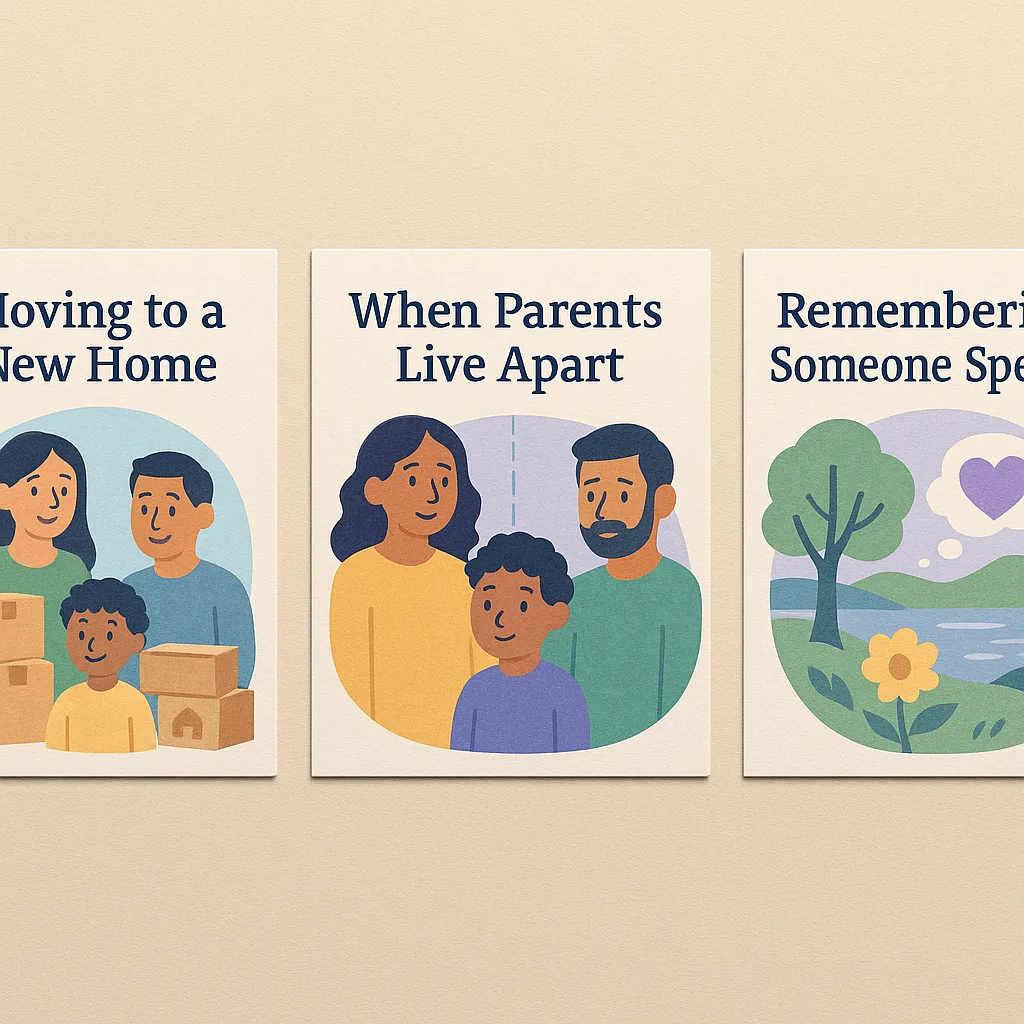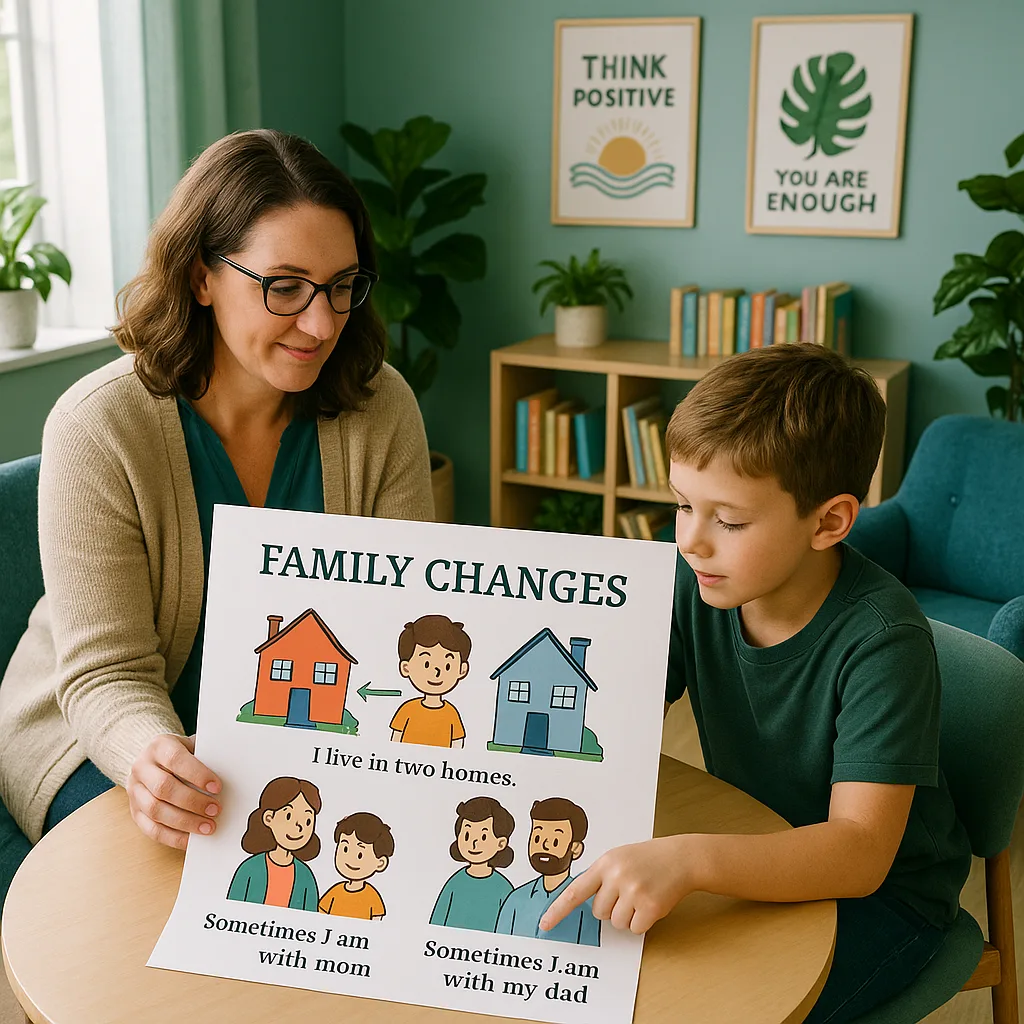Visual Social Stories for Student Transitions
Find Your Calm: Visual Social Stories for Major Life Changes
When students face life’s biggest challenges, words alone aren’t always enough. That’s where the magic of visual storytelling comes in.
Life throws curveballs at our students – divorce, moving to a new home, or losing someone they love. As educators and mental health advocates, we witness firsthand how these major transitions can shake a child’s world. Traditional counseling approaches are valuable, but sometimes we need something more tangible, more visual. That’s where poster machine maker social stories become powerful tools for healing and understanding.
In my years working with school districts across the country, I’ve seen how visual narratives can bridge the gap between confusion and comprehension. Creating personalized social stories isn’t just about making pretty pictures – it’s about crafting emotional roadmaps that guide students through their darkest valleys toward brighter tomorrows.
Understanding Poster Machine Maker Social Stories
Social stories are sequential visual narratives that help students understand and navigate complex situations. Originally developed for children with autism, research shows these tools benefit all learners, especially during emotional upheaval. When we combine the therapeutic power of social stories with modern poster machines, we create resources that are both professional and deeply personal.
The beauty of using a poster machine lies in its versatility. Unlike pre-made materials, you can customize every aspect – from the characters that look like your students to the specific scenarios they’re facing. This personalization makes the stories more relatable and effective.
Recent studies from the American Psychological Association highlight how visual learning tools significantly reduce anxiety in children experiencing trauma. By creating large-format visual stories, we give students something tangible to hold onto during turbulent times.

A calming social story helps students process difficult emotions
How Poster Machine Maker Social Stories Support Different Transitions
Let’s explore specific scenarios and how visual stories can help
Divorce & Separation
Visual stories showing two loving homesCreating Understanding
Design stories that normalize having two homes, show consistent love from both parents, and illustrate new routines. Use warm colors and familiar objects to create comfort.Moving to New Places
Adventures in new neighborhoodsBuilding Excitement
Create visual tours of the new school, highlight fun places to explore, and show how friendships can grow. Include maps and familiar anchors to reduce anxiety.Grief & Loss
Celebrating love that continuesHonoring Memories
Develop stories that validate feelings, show healthy expression of grief, and celebrate memories. Use soft, comforting imagery with nature elements for healing.Collaborating with School Counselors: A Team Approach
Creating effective social stories requires collaboration between educators, counselors, and families. In my workshop experiences, I’ve found that the most impactful stories emerge when we combine clinical expertise with creative design. School counselors bring essential insights about developmental appropriateness and therapeutic messaging, while teachers understand individual student needs and learning styles.
Start by scheduling a planning session with your school counselor. Together, review the specific situation and identify key messages to convey. For instance, when addressing divorce, counselors might emphasize that the child isn’t responsible for adult decisions. This core message then guides your visual narrative.
Consider using the Campus Pro 36 Poster Maker Advanced Package for creating these materials. Its large format allows for detailed sequential panels that students can easily follow, while the high-quality printing ensures professional results that validate the importance of their experience.
Step-by-Step Guide to Creating Your Social Story
Identify the Need
Meet with counselors and families to understand the specific transition
Script the Story
Write simple, positive language that acknowledges feelings
Design Visuals
Create or source appropriate images with calming colors
Print & Share
Use your poster machine to create durable, professional materials
Measuring Impact and Adjusting Approaches
The effectiveness of visual social stories can be measured through both formal and informal assessments. Observe students’ emotional regulation before and after story implementation. Many educators report decreased anxiety behaviors, improved communication about feelings, and better adaptation to new routines.
Document these changes through simple tracking sheets. Note when students independently seek out their social stories – this self-advocacy indicates the resource is meeting their needs. Additionally, gather feedback from families about home behaviors and emotional processing.
Based on my experience implementing these programs nationwide, expect to see initial improvements within 2-3 weeks of consistent use. However, remember that healing isn’t linear. Some days, students might need their stories more than others, and that’s perfectly normal.
One particularly moving example comes from a school in Oregon where we created social stories for military children whose parents were deployed. Using a poster machine, we printed sequential stories showing video calls, care packages, and eventual homecomings. Teachers reported that students would often be found quietly looking at these stories during difficult moments, finding comfort in the visual reminder that their parent would return.
Supporting the Whole School Community
Creating visual social stories extends beyond individual student support – it builds a more compassionate school culture. When we normalize discussing difficult life transitions through visual aids, we reduce stigma and encourage empathy among all students.
Consider hosting professional development sessions where teachers learn to create their own social stories. Share successful examples and provide templates. The investment in a quality poster machine becomes even more valuable when multiple staff members can utilize it for various therapeutic and educational purposes.
Furthermore, involving students in creating social stories for younger peers fosters leadership and emotional intelligence. High school psychology classes might develop stories for elementary students, creating meaningful cross-age mentorship opportunities.

